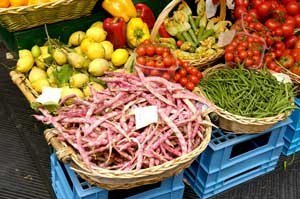All vegetables contain naturally occurring enzymes. In some vegetables, unless these enzymes are deactivated with heat before the vegetable is frozen, the enzymes will continue to break down and age them even at freezing temperatures. Blanching destroys these enzymes and helps preserve the vegetables flavor, color and texture during storage, as well as slowing down nutrient loss. If frozen without being blanched, some vegetables tend to soften and lose their flavor after a period of storage.
Blanching also diminishes the number of microorganisms that may be present on foods and brings out the color in green vegetables.
Use a blanching pot or large kettle full of water that has a tight fitting lid. The pot should be big enough to have a basket or strainer placed inside of it for lifting vegetables in and out of it. It the pot doesn't come with its own basket, you can use any colander or wire mesh strainer big enough to hold approximately 1 pound of vegetables. Immerse 1 pint/pound of vegetables in a gallon of hard boiling water, cover, and leave boiling for recommended amount of time. Make sure vegetables are fully submerged in water. When time is up, remove vegetables and plunge them into a sink full of icy water or run them under very cold water until completely cooled. Drain and dry on paper towel or cloth to prevent ice crystals from forming while freezing.
Use a large pot with a tight-fitting lid. Fill bottom with 2-3 inches of water and place a steaming rack in the bottom of the pot so that water does not touch the bottom of the rack. Boil water and place vegetables on the rack in a single layer no more than 2 inches deep. Cover pot. Steam for recommended amount of time (see individual vegetables). Remove cool, drain and pat dry vegetables for freezing as in water-blanching method.
In a single layer, place 1 pound of vegetables into a shallow, microwave container filled 1/2 cup water and cover. Microwave for recommended time (see individual vegetables). Remove, cool and pat dry the same as water blanching. Although this method is convenient, results can vary. Variations in microwaves, containers used, how vegetables are layered and when and if they are stirred during the process can all effect results.
This method saves a lot of time by blanching and cooling meal-sized vegetables that you have pre-sealed in boilable bags. Fill boilable bags up with a meal-sized portion of vegetables so that the bags are no more than 1 inch thick (add butter or seasoning if desired). Expel air and seal bags with an automatic bag-sealer or by placing the end of the bag under a thick towel or moist cloth and sealing it with an iron. Drop sealed bags in pot of boiling water and cover pot. Remove after boiling for recommended time (see individual vegetables) and plunge bag in ice water until completely cooled. Pat bags dry with a towel before freezing.
When using water for blanching, generally figure 1 gallon of water per pound/pint of vegetables. Distilled or filtered water will give foods the best taste. Avoid hard water.
The amount of time required for blanching will vary from vegetable to vegetable (see individual vegetables for times), but should be timed as carefully as possible. Under blanching will destroy soft tissues without destroying all the enzymes. Over blanching will discolor vegetables, change their texture and leach out valuable nutrients. Properly blanched vegetables will be heated through to the center, but still have a firm texture. The time needed to cool vegetables in ice water is approximately the same as it takes to blanch them.
When water blanching, start counting time as soon as the water returns to a boil after placing vegetables in the water. If the water takes longer than 1-2 minutes to return to a boil, consider blanching smaller batches of vegetables at a time. Blanching times for boiling bags is approximately double that of water blanching.
Vegetables need to be cooled quickly and thoroughly after blanching to stop the cooking process. To cool them, plunge baskets of vegetables quickly into a large kettle or sink filled with cold water, (at least 60°F or below). Keep water cool by adding ice frequently (approximately one pound of ice for each pound of vegetables). Vegetables should be cooled for approximately the same amount of time as you blanched them.
Drain extra moisture after cooling to avoid a loss of quality during freezing.

Add your voice! Click below to comment. ThriftyFun is powered by your wisdom!
Barbara, thank you so much for the much needed info! I am freezing fresh asparagus for the first time. Thanks again! Kim
Add your voice! Click below to comment. ThriftyFun is powered by your wisdom!